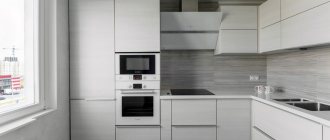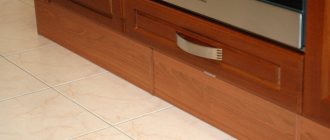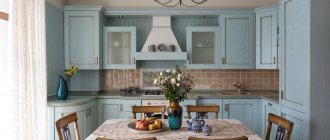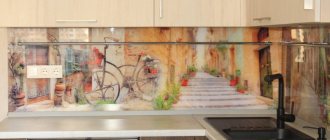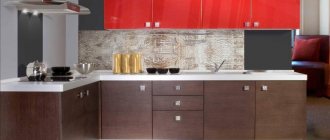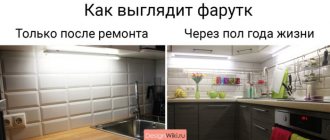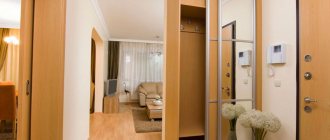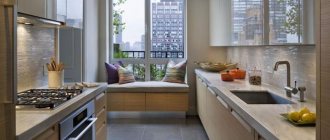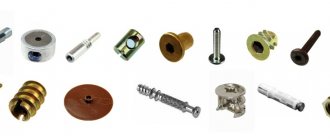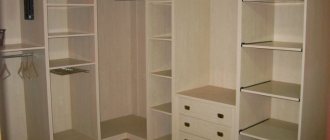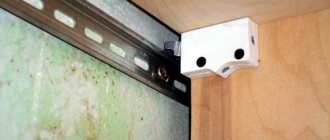Designers often decide for the owners what the kitchen apron will be like, offering the optimal solution in their opinion. However, many people prefer to do the repairs themselves, and when they begin to study this issue, they are surprised to discover a lot of finishing options. We will tell you what types of kitchen aprons there are, list their features, advantages and disadvantages so that you have complete information before starting the renovation.
In this article: [Hide]
- Ceramic tile apron In what case is it better to use
- Laminated wall panel backsplash
- In what case is it better to use
- Artificial stone apron
- In what case is it better to use
- Apron made of flexible veneer or flexible stone
- In what case is it better to use
- Tempered glass apron
- In what case is it better to use
- Apron made of wooden boiserie wall panel
- In what case is it better to use
- Mosaic apron
- In what case is it better to use
- Kitchen apron made of ABS plastic
- In what case is it better to use
- How to determine the size of a kitchen apron
Ceramic tile backsplash
Kitchen walls were tiled long before the term “kitchen apron” appeared. Ceramic tiles are still in demand and are represented on the finishing materials market in a wide range.
Popular sizes of ceramic tiles for kitchen splashbacks:
- 10 x 10 cm. Small square tiles open up wide possibilities for creating original compositions on the wall in the work area. The speed of work depends on the experience and complexity of the drawing;
- 7.5 x 15 cm. Vertical cladding of the apron with rectangular tiles looks very stylish, this option is perfect for modern interiors. If a loft is closer to you, this tile is the easiest way to create an imitation of brickwork;
- 20 x 30 cm. The first of the large-format types of wall tiles is ideal for an apron in a spacious kitchen. Putting it down is quick and easy.
Design options for ceramic tile backsplashes
As for the texture, this is a matter of taste. You can choose glossy or matte tiles.
Before tiling the apron, the wall must be carefully leveled.
In what case is it better to use
This type of kitchen apron is appreciated by adherents of traditions, by everyone who prefers a reliable, time-tested finish and wants to save money.
The advantages of ceramic tiles for a kitchen backsplash:
- Reliable protection of the entire wall surface, including behind the sink and stove.
- The ability to create an exclusive pattern using a play of colors and textures.
- Piece material, unlike sheet material, does not require cutting.
- When choosing inexpensive tiles, finishing will cost very little.
Disadvantages of ceramic tiles for a kitchen backsplash:
- Requires leveling of surfaces.
- To make it beautiful, you need to work carefully.
- The work itself is quite dirty.
- If the quantity is calculated inaccurately, there may not be enough tiles or there may be a surplus.
The labor intensity of the work is compensated by the durability of the finish. Cleaning a ceramic apron is very simple; it can only be cracked with a targeted blow to the wall. Therefore, it will serve for decades.
Options for installing corners: after tiling, before laying tiles
Moldings can be installed both after laying the tiles and before. In the first case, the profile is located above the tile at the junction of the surfaces. This installation option can be used equally successfully for both external and internal bathroom joints.
If the corner cap is glued before laying the tiles, the corner is carefully glued at the junction of the walls, and then you can begin installing the tiles.
Important! You can ensure a beautiful appearance of the finished product if the edges of the tiles are perfectly smooth.
Laminated wall panel backsplash
Chipboards, better known as chipboards, are a good basis for making budget types of kitchen aprons.
To make the material resistant to moisture and temperature, it is laminated, that is, the slabs are finished with a polymer film impregnated with melamine resin. The resulting material is called chipboard. Chipboard lined with plastic has the same properties.
Chipboard with a thickness of 8-10 mm is suitable for a kitchen apron. Thicker slabs are used to make furniture.
The front surface of the material comes in a wide variety of colors and can imitate any texture, stone, for example, or wood.
Design options for aprons made of laminated wall panels
Apron made of laminated chipboard to look like stone.
Wood-look chipboard apron.
In what case is it better to use
If you want to quickly, cleanly and inexpensively tidy up the wall between the countertop and cabinets, consider that you have found the optimal type of kitchen apron. This option is suitable for renovations in your own or rented apartment, when you want to save time, money and nerves.
Advantages of a chipboard apron:
- Does not require careful leveling of walls as for tiles.
- Simple installation without the involvement of specialists.
- Presentable appearance of the finish.
- Resistance to humidity, heat from the stove.
- Good mechanical strength.
- Large assortment of decorative design of slabs.
- Low price.
Disadvantages of a chipboard apron:
- The finishing belongs to the must-market category, so no matter how much you want, it will not look rich and original.
- The durability of the apron depends on the quality of installation. Particular attention should be paid to the tightness of the joints in the corners, using special corners and if there is no edge, the edges of the apron should be sealed with sealant.
All this applies to chipboard with improved performance, that is, laminated or coated with plastic. Chipboard aprons should not be left in place , otherwise they will not be washed later. This is also a minus. But with proper attention, the finish will last in its original form for at least 10 years, and this is a big plus.
Dismantling the corner
This is not a desirable process. If the design project requires it. It will block the access of moisture to the inner corners. Revive the interior, make a completely new version of your old room, bring it closer to perfection. Then let's begin.
Degrease and dry the corner joint and the new corner. We apply moisture-resistant or ceramic glue. Carefully glue the corner to the surface. If cracks and voids are found, we fill them with acrylic glue for reliable fixation and sealing.
Artificial stone apron
A fashionable finishing material based on polyester resins with the addition of stone chips is produced under the name artificial stone. It looks quite realistic and noble, but weighs much less than its natural counterpart.
An artificial stone apron is usually made together with a countertop. During installation, they are monolithically glued together without forming seams. This feature of the installation and the absence of pores in the structure of the material eliminates the accumulation of dirt and the proliferation of microbes.
Design options for artificial stone aprons
In what case is it better to use
This type of kitchen apron will appeal to lovers of non-standard interior solutions and fans of the classic style. Classics and stone, even artificial ones, combine perfectly; the wall and table surface look rich and noble, especially in addition to wooden facades.
Advantages of an artificial stone apron:
- Hygiene.
- Absolute protection of walls from moisture.
- Impeccable appearance.
- Strength, durability.
- Defects acquired during operation can be easily eliminated by grinding.
Disadvantages of an artificial stone apron:
- A small number of color and texture solutions compared to other types of finishes.
- Quite a high price.
- Labor-intensive, responsible professional installation.
The disadvantages of this option for wall design are offset by the service life, calculated in decades.
Apron made of flexible veneer or flexible stone
A thin section of natural stone on a soft artificial base is called flexible stone or flexible veneer.
Sandstone, often with a predominance of quartz, and other rocks are used to make finishing materials. The substrate is usually dense textiles, and the binding component is polymer resins. Available in rolls and slabs.
Flexible stone in the form of a roll.
Flexible stone in the form of a slab.
The finished material combines the decorative properties of stone and the elasticity of rubber.
Design options for aprons made of flexible stone
In what case is it better to use
This is a new finishing material that is rapidly gaining popularity. If you are attracted by the beauty of natural stone and are not bothered by the presence of seams during installation, choose this type of apron for the kitchen.
Advantages of an apron made of flexible stone:
- Externally indistinguishable from natural stone.
- Fireproof.
- Hygienic.
- The surface is resistant to mechanical stress.
- Thanks to its flexibility, it fits easily into corners.
- For high-quality wall cladding, you do not need the help of specialists.
Disadvantages of an apron made of flexible stone:
- Compared to ordinary artificial stone, it forms a seam at the junction with the countertop.
- Requires wall alignment.
- After cladding, the surface must be treated with a special protective primer.
- Quite a high cost.
Despite the shortcomings, this type of kitchen apron will last, according to experts, for at least 30 years.
Types of profile by configuration
There are several types of bathroom corners. Among them are the following:
- one-sided - the tile is pressed against the groove of the corner, and the second one is in close contact with the lining of the second wall. The element is suitable for work only on straight or sharp corners;
- double-sided - along the length of the inner corner, fittings are embedded in the adhesive mixture for installing tiles, and then a finishing strip with flexible elements located in the middle is fixed in it. Its cost is slightly higher than one-sided. Used for work at angles greater than 90 degrees;
- external - used to mask corners on boxes. They have a streamlined shape. They ensure safety of movement on tiles and also perform a decorative function;
- internal - has a concave shape. It is used when it is necessary to mask the seams between tiles on internal corners.
Each type has its own characteristics of shape, material of manufacture and purpose.
Difference between internal and external
When choosing an internal or external corner for tiles, it is recommended to take into account that there are some differences between them. For example:
- the internal decorative element is a kind of cavity located between the walls. External - looks like a protruding part;
- the main difference is the purpose of the two elements;
- Installation of an internal corner is much simpler than an external one. Unevenness can be corrected by using grout or glue.
Taking into account these properties and qualities, you can choose the decorative element that is suitable for a certain type of work.
Tempered glass apron
As soon as they appeared on the market, glass splashbacks immediately became the favorites of interior designers. We are talking about options with photo printing, which are called skinali and look incredibly impressive.
For the production of aprons, impact-resistant tempered glass, up to 8 mm thick, is used. It is not afraid of high temperatures and mechanical influences, but if, after making an effort, it is broken, the glass breaks into harmless fragments with rounded edges.
Today there are different types of tempered glass kitchen aprons on sale:
Transparent apron. The purpose of its installation is to additionally protect the existing finish from splashes of water and grease. If this option seems boring, you can order frosted glass or a texture, such as satin or sandblasting. Such solutions are found when decorating doors in shower stalls.
Transparent glass apron.
Plain (painted) apron. The paint is applied from the inside and undergoes heat treatment, so it does not lose its brightness throughout its service life. The number of color variations amounts to thousands of shades to suit every taste and every interior.
Plain glass apron.
Apron with UV printing. Using a special printer, an image is applied to the inner surface of the glass, and which one depends on the imagination of the designers. Under the influence of UV radiation, the picture freezes, impressing with its depth and expressiveness.
Apron with UV printing.
Design options for glass splashbacks
Each type of glass kitchen apron is good in its own way; the choice depends on the personal preferences of the owners.
In what case is it better to use
If you are going to decorate a kitchen in a Scandinavian style, you like neoclassicism, minimalism, hi-tech and other modern interiors, glass splashbacks are what you need.
Advantages of glass aprons:
- Strength.
- Hygiene.
- Thermal resistance.
- Infinitely large selection of design variations.
- Easy to clean like any glass.
Disadvantages of glass aprons:
- Careful alignment of the wall and additional finishing are required if the glass is transparent;
- Any technological holes are laid during production; it will not be possible to drill glass, for example, for roof rails;
- Water marks and dirt will be noticeable on the surface of the apron, so you will have to keep it clean, especially if sunlight falls on the glass.
As for skinals, they are so amazingly beautiful that they produce a wow effect even on people who are indifferent to interior design. At the same time, aesthetes and adherents of noble classics consider such aprons tasteless.
Apron made of wooden boiserie wall panel
From the palaces of the French aristocracy, boiserie migrated to our houses and apartments, including kitchen aprons. These are wall panel modules made of natural wood that resemble clapboard and are mounted in a groove. Boiserie can decorate the wall above the tabletop on its own or in combination with stone.
Design options for aprons made of wooden bowser panels
In what case is it better to use
In rustic interiors, especially Provence, this type of kitchen apron looks great, cozy and harmonious. If you are attracted to provincial motifs or eco-style, it is interesting to experiment with boiserie installation.
By the way, boiserie panels are used to decorate not only the work area, but also all the walls in the kitchen, especially if it is a kitchen-dining room. Often the installation is carried out to the middle of the wall, separated by transverse lamellas and continued higher.
Advantages of a boiserie apron:
- It looks cozy and original.
- You can always change the shade by tinting or “aging” it with patination.
- Few people have such kitchen aprons.
Disadvantages of a boiserie apron:
- Wood is hygroscopic, fire hazard and absorbs odors, so the panels will have to be periodically impregnated with special compounds.
- For the same reasons, it is not recommended to install them behind the sink and stove.
- It is quite difficult to clean the seams between the boards from dust and dirt.
Fragmentary installation of boiserie is an interesting idea that deserves attention, but sewing up an entire apron with them is not particularly practical.
Mosaic apron
The mosaic wall in the kitchen work area looks bright and original. However, many are stopped by the supposedly painstaking installation of small elements. In fact, this type of kitchen apron consists of blanks, usually 30 x 30 cm, which greatly simplifies installation.
The basis of the workpiece is a mesh onto which the mosaic is attached at the factory. Mosaic elements come in square, round, pebble, shell and other interesting shapes, not to mention colors.
Mosaic blanks are glued with tile adhesive; there is no need to be tricky with leveling the walls. But it is better to use epoxy grout; it does not absorb dirt and does not darken over time.
Mosaic apron design options
In what case is it better to use
Fans of colorful decors and ethnic motifs will definitely like this type of kitchen apron.
The size of the kitchen is not important, but it is worth considering that such a kaleidoscope will make a small room even smaller.
Advantages of a mosaic apron:
- You can choose from ceramics, glass, metal, stone, wood, or combine blanks from different collections.
- A mosaic apron is not afraid of moisture, especially if the seams are protected with epoxy grout.
- Good heat resistance allows you to lay mosaics on the wall behind the slab.
- No special skills are required to install mosaics.
Disadvantages of a mosaic apron:
- Epoxy grout is expensive and you will need a lot of it.
- The surface of the walls and seams will require careful care.
Considering that a mosaic apron will last about 2 decades for clean owners, investing in grout pays for itself.
Material calculation method
To determine the amount of consumables, you need to measure the area of the wall that the apron will occupy.
There are some average standards on this matter.
- The average height of the working area varies between 55-75cm.
- It is permissible to install the apron to the floor.
- The bottom level of the tile trim should be below the countertop.
- The height of the apron can reach the level at which the hood is located.
- The length of the laid tiles is chosen according to personal wishes.
Kitchen apron made of ABS plastic
Impact-resistant thermoplastic (ABS) replaced the usual PVC panels and immediately won the trust of consumers.
Unlike its flimsy predecessor, this is an environmentally friendly, durable material that is resistant to moisture and abrasives. The only similarity between these materials is their more than affordable cost.
Aprons made of ABS plastic come in any color, as well as imitation stone, wood or brick. Thanks to the ability to apply photo printing on ABS panels, you can purchase an option with an original design, almost like a skinali.
Design options for aprons made of ABC plastic
In what case is it better to use
If you want to save money on renovations, but budget chipboard or tiles don’t suit you, this type of kitchen apron will be an excellent alternative.
Another reason to choose this option is the desire to decorate the work area and have before your eyes not a stone or wood texture, but a field of tulips, city lights at night, or whatever you like best.
Advantages of an apron made of ABS plastic:
- Environmentally friendly.
- Thermal resistance up to + 80°C versus 45°C for PVC panels.
- Hygiene.
- Good mechanical strength;
- Lighter weight compared to tempered glass.
- Simple installation using liquid nails without special leveling of the walls.
- You can wash with abrasive sponges, but not with iron brushes.
- Budget cost.
Disadvantages of an apron made of ABS plastic:
- It is not advisable to place it behind a stove that is close to the wall.
- On the south side, panels with a bright pattern, unlike glass skinals, will fade.
The service life of this type of kitchen apron largely depends on the owners. With proper care and careful use, the walls in the work area will remain clean and beautiful for many years.
